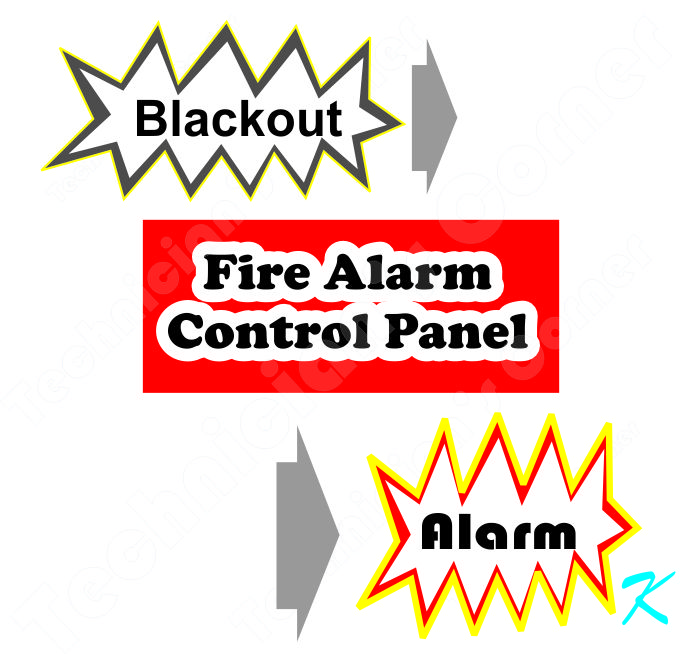Long Term Issues
Even if you can find parts or a substitute panel, when - not if - something else goes wrong, you may not be able to find parts and the panel has to be replaced on an emergency basis. Overtime costs and possible fire walks will be included in the replacement. If the panel is not replaced now, while there isn't an emergency, the panel will be replaced later, when there is an emergency. Replacement now is cheaper for the owner.
The panel is getting old. My personal recommendation is that you replace the panel now. Everyone will be happier in the long run; you will also have a panel you can service easier.
Put It On-Test
Before checking anything on the panel, remember to call the monitoring company to make sure they don't send the fire department while you are working on the panel. Just saying.
I have some Questions for My Understanding of the Problem
Does the panel completely die so nothing works at all when utility power is turned off at the circuit breaker, or does the panel go into alarm when the utility power is turned off? Is there a trouble light on the panel at any time, either with utility power off or with utility power on?
Also, is there a red alarm light that comes on, and which zone does it show up on? If there is a red alarm light that comes on, can the horns be silenced or panel reset once the alarm light comes on?
In any case, the problem can be caused by the panel electronics, the batteries, or the wiring and devices outside the panel. There are ways to test each possibility, and they all need to be tested before just replacing the panel because the panel may or may not be where the problem is located.
Batteries
The batteries are wired in series, making them a single 24 volt nominal (24 volts in name only, the batteries could be anywhere from about 20 volts to 27.5 volts, depending on how well they are charged) and are 7 Amp Hours (roughly capable of providing 1 amp of current over 7 hours).
Batteries are the cheapest and easiest problem to solve. The batteries, though, have to be tested under load conditions because they perform differently when they are actually powering the panel.
The first thing to test is the battery voltage is under normal circumstances (when utility power is on). Then test the battery voltage when utility power is off.
The normal utility power-on voltage you measure on the batteries should be somewhere around 25 volts to 27.5 volts. When the circuit breaker is turned off, the voltage on the batteries should drop slightly, and slowly reduce over 24 hours, to about 20 volts. With the utility power off, the rule of thumb measurements are with horns blaring, the voltage on the batteries shouldn't drop more than 3 volts in the first minute, and then pretty much hold that voltage for a few minutes. If the voltage drops more than 3 volts, the batteries are definitely bad and need replacement. If the batteries drop less than that, the batteries may still need replacement, but probably aren't the cause of the problem. Just replace the batteries if they're even questionable, they're cheap.
By the way, the batteries should be replaced in pairs to keep them matched. Different manufacturers make the batteries slightly different, and as the batteries age, they change capabilities.
Wiring and Device Trouble Outside the Panel
The problem you are experiencing is probably with the panel itself, but the problem could be caused by something outside the panel. Test this before just replacing the panel. If the problem is outside the panel, replacing it won't fix the issue and the issue still has to be solved.
Testing for this takes a little more care. Some of the wiring has to be disconnected, and reconnecting the wiring afterwards becomes a real problem if any of the wires are misconnected.
Before disconnecting anything, take pictures of every connection, to use when reconnecting. The camera is an excellent memory device and is one thing that should be used. Then use tape and a marker to label each wire and where it is landed on the circuit board. Stay away from the wires in the lower left area, that's utility power.
Then, disconnect just the zone input wires, these are labeled on the circuit boards as INP1, INP2, INP3, Etc.
Make sure all of the zone input wires are disconnected from all of the zones on the panel. The trouble light and buzzer on the panel should turn on at this point. By disconnecting all the zone input wires, you are eliminating anything that can set off the panel when the utility power is turned off.
Once the wires are disconnected, if the problems don't show up when utility power is turned off, the problems are probably caused by something in the building wiring or with a device outside the panel. If the problems show up anyway, the problems are inside the panel, probably with the panel electronics.
Tight Wiring
One other possibility is in the wiring between the back box and the electronics inside the panel. This area is tight, and over time the insulation on a wire might have been pierced, causing the symptoms you describe. Just make sure that hasn't happened.
Long Term - Replace the Panel Anyway
Even if it turns out not to be a problem with the panel, plan on replacing it soon. It is no longer supported by the manufacturer, and it will take the course of all electronics - it is going to die sometime.
Replace the panel now, while everyone is in control of the situation. Emergency replacement is more expensive and comes with the headaches of trying to get the replacement accomplished on short notice.
Douglas Krantz
